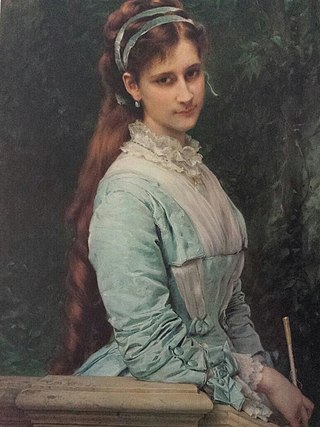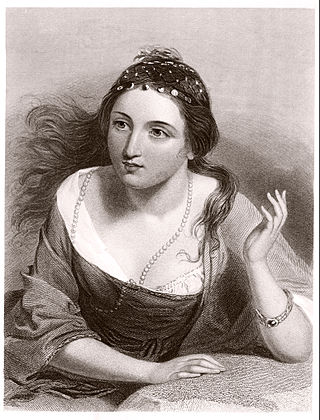
Medora is a city in Billings County, North Dakota, United States. The only incorporated place in Billings County, it is also the county seat. Much of the surrounding area is part of either Little Missouri National Grassland or Theodore Roosevelt National Park. The population was 121 at the 2020 census. It is part of the Dickinson Micropolitan Statistical Area.

Augusta Maria Leigh was the only surviving daughter of John "Mad Jack" Byron, the poet Lord Byron's father, by his first wife, Amelia, née Darcy.

Marquis de Morès et de Montemaggiore was a French duelist, frontier ranchman in the Badlands of Dakota Territory during the final years of the American Old West era, a railroad pioneer in Vietnam, and antisemitic politician in his native France.

Elizabeth Medora Leigh was the third daughter of Augusta Leigh. It is widely speculated that she was fathered by her mother's half-brother Lord Byron; this is supported by comments from his widow, even though her mother's husband, Colonel George Leigh, was her legal father.

Medora de Vallombrosa, Marquise de Morès, was an American heiress who married the Marquis de Morès.

Minnesela is a ghost town and was the first settlement in and county seat of Butte County, South Dakota, United States. Minnesela was founded in 1882 and was located three miles southeast of present-day Belle Fourche. The railroad's decision to bypass Minnesela and to continue on to Belle Fourche in 1890 caused the town to be abandoned by 1901.

The Chateau de Mores in Medora, North Dakota, United States, is a historic home built by the Marquis de Mores in 1883 as a hunting lodge and summer home for his family and guests. The home is now part of the 128-acre (0.52 km2) Chateau de Mores State Historic Site, which also includes Chimney Park and de Mores Memorial Park.

Don Levingston Short was a cattle rancher and politician from Billings County, North Dakota. His career in politics reached its pinnacle when he was elected as a U.S. Representative in 1958, and was a member of the United States Congress from January 3, 1959, to January 3, 1965.

The 2010 United States Senate election in North Dakota took place on November 2, 2010, alongside other elections to the United States Senate in other states as well as elections to the United States House of Representatives and various state and local elections. Incumbent Democratic Senator Byron Dorgan announced in January 2010 that he would not seek reelection, leading to the first open seat election since 1992. Governor John Hoeven won the seat in a landslide, taking 76.1% of the vote, sweeping every county in the state, and becoming North Dakota's first Republican senator since 1987. Hoeven's 54 point margin of victory was a dramatic and historic shift from the previous election for this seat, when Dorgan won reelection in a 36 point landslide and himself swept every county in the state.
Elizabeth Lee may refer to:

The De Mores Packing Plant Ruins near Medora in Billings County, North Dakota, is a historic site listed on the National Register of Historic Places (NRHP). The site is now preserved as Chimney Park, the largest open space within Medora's city limits.

The Von Hoffman House at Broadway and 5th St. in Medora, North Dakota was built in 1884. It was listed on the National Register of Historic Places in 1977. The listing included one contributing building and one contributing structure.

Peaceful Valley Ranch is about 3 miles (4.8 km) from the town of Medora, North Dakota in the South Unit of Theodore Roosevelt National Park, in western North Dakota. The ranch dates from 1885, when Benjamin Lamb bought the land and built its first buildings. After operating as a ranch, primarily raising horses, the ranch was developed by the Olsen family as a dude ranch before it was acquired by the National Park Service, and incorporated into the Roosevelt Recreation Demonstration Area, which eventually became the present national park. The ranch forms the core of the national park's South Unit. It overlooks the Little Missouri River, in the Little Missouri badlands.

The St. Mary's Catholic Church in Medora, North Dakota was built in 1884 by Peter Book, a builder who also constructed the Von Hoffman House. It was listed on the National Register of Historic Places in 1977.
A cattle town was a frontier settlement in the Midwestern United States that catered to the cattle industry. The economies of these communities were heavily dependent on the seasonal cattle drives from Texas, which brought the cowboys and the cattle that these towns relied upon. Cattle towns were found at the junctions of railroads and livestock trails. These towns were the destination of the cattle drives, the place where the cattle would be bought and shipped off to urban meatpackers, midwestern cattle feeders, or to ranchers on the central or northern plains. Cattle towns were made famous by popular accounts of rowdy cowboys and outlaws who were kept under control by local lawmen, but those depictions were mostly exaggeration and myth.
The De Mores Memorial Park in Medora, North Dakota was listed on the National Register of Historic Places in 2019.

The Theodore Roosevelt Presidential Library is a planned museum focused on the life and legacy of Theodore Roosevelt, the 26th president of the United States. It is to be constructed at a site to the west of Medora, North Dakota, near Theodore Roosevelt National Park, which preserves sites associated with Roosevelt's travel in North Dakota between 1883 and 1887. A site in the Badlands of Medora was selected in 2020, as well as the design architect Snøhetta and the architect of record JLG Architects.
Duke of Vallombrosa was a title created for the House of Manca. The present holder is disputed.
Albert Henry Kuhn was a Washington State pioneer and businessman. During his early career, Kuhn tried a variety of jobs, moving from state to state until he settled in Washington in 1884 and entered the logging business, where he remained for the rest of his career. He began as a logging foreman, but gained recognition in business circles over time. Eighteen years later, he was one of the founders of a new logging venture: Hoquiam Lumber and Shingle Company. In 1917, he became the manager and biggest shareholder of the Hoquiam shingle mill.

Medora is a feminine given name popularized by George Gordon, Lord Byron for the heroine of his 1814 poem The Corsair. The name of the romantic heroine has since been used for girls in the Anglosphere. Variants of the name in use in the 19th century were Maddora, Madora, Medorah, Medoria, Medorra, and Midora. Medoro, a similar name, is a male character in the 1516 Italian epic poem Orlando Furioso by Ludovico Ariosto, a poem which influenced later works. Medora is also a surname.














